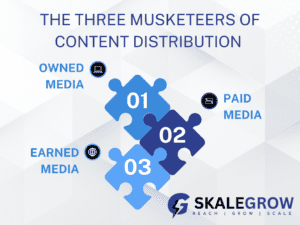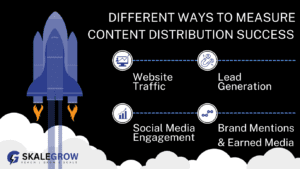What if you could create the perfect B2B content engine? It would include insightful white papers, visually stunning infographics, or blog posts with actionable tips. You might also know your B2B content distribution strategy has the power to transform your target audience’s understanding of your industry. But here’s the rub: How do you get your content masterpiece in front of the decision-makers who need it most?
The right content distribution strategy propels your content from a lonely corner of your website to the desks (and inboxes) of the very people who can benefit from it. It ensures that your content finds its rightful audience, creating brand awareness, generating leads, and ultimately driving business growth.
The Three Musketeers of Content Distribution

The Three Musketeers of Content Distribution
Before diving into the vast landscape of content distribution channels, let’s understand the three main categories that form the foundation of any effective B2B content marketing:
- Owned Media: This is your digital homestead – your website, blog, social media channels, and email lists. These platforms offer you direct control over your message and audience. Think of it as your own personal content kingdom.
- Earned Media: It is the golden ticket of content distribution. It’s when other publications, websites, or influencers share your content with their audience, essentially giving it a stamp of approval and boosting its credibility. Earned media is like receiving a glowing recommendation from a trusted friend in the industry.
- Paid Media: Paid Media involves strategically using paid advertising platforms like social media ads, sponsored content, or search engine marketing (SEM) to promote your content to a wider audience. Paid media acts as a megaphone, amplifying your content’s voice and reaching an even larger pool of potential customers.
Choosing the Right Channel for the Job
Owned Media Channels
- Website & Blog: These are the digital hubs of your content universe. Here, you have your content library, nurture leads through targeted CTAs (calls to action) and establish yourself as a thought leader in your industry.
- Social media: Perfect for promoting bite-sized, engaging content, sparking conversations, and fostering real-time connections with your audience. Tailor your approach to each platform: X is ideal for quick updates and industry insights while LinkedIn shines for thought leadership content.
- Email Marketing: Email Marketing is your direct line to a nurtured audience. Build an email list with high-value content tailored to specific interests and needs, then use it to promote relevant content and nurture leads further down the marketing funnel.
Goals: Brand awareness, website traffic, lead generation, content promotion, and thought leadership.
Earned Media Channels:
- Guest Blogging: Contribute valuable content to relevant industry publications or blogs. This allows you to reach a pre-existing, engaged audience who may be highly interested in your expertise.
- Public Relations: Build relationships with journalists in your industry. Pitch them newsworthy stories or insights related to your content, potentially securing valuable media coverage and boosting brand reputation.
- Industry Awards & Recognition: Winning awards or getting featured in industry reports adds credibility and attracts attention to your brand and content. These accolades serve as social proof, showcasing your expertise to potential customers.
Goals: Brand awareness, thought leadership, website traffic (indirectly through increased brand reputation), and lead generation (indirectly, through increased brand reputation).
Paid Media Channels:
- Social Media Ads: Target specific demographics and interests on platforms like LinkedIn or X to promote your content directly to qualified audiences. This allows for hyper-targeted content promotion, ensuring your message reaches the right people at the right time.
- Search Engine Marketing (SEM): Pay to have your content appear at the top of search engine results pages (SERPs) for relevant keywords. This helps potential customers discover your content when they’re actively searching for information you can provide.
- Content Syndication: Pay to distribute your content across a network of high-traffic websites, reaching a wider audience and potentially generating more leads. This can be a great way to expand your reach beyond your own ecosystem.
Goals: Website traffic, lead generation, and brand awareness (depending on the platform).
Aligning Content Distribution Channels with Goals
Spreading yourself too thin across every available content marketing channel can be overwhelming and counterproductive. The key is to find the perfect balance between your content distribution channels and goals for an efficient B2B content distribution strategy. Here are some key considerations:
- Content Type: Different content formats thrive on different channels. Long-form content like white papers and eBooks might be best promoted through email marketing and gated downloads on your website, while infographics and short videos can shine on social media platforms like LinkedIn and X.
- Target Audience: Understand where your ideal customer spends their time online. Are they active on specific social media platforms? Do they frequently visit industry publications or forums? Aligning your distribution channels with your audience’s preferred platforms maximizes the chances of your content reaching the right people.
- Marketing Goals: What are you hoping to achieve with your content? Is it brand awareness, lead generation, website traffic, or a combination? Each channel has its strengths and weaknesses in achieving these goals. Paid advertising might be best for rapid lead generation, while organic social media might be a good long-term strategy for building brand awareness.
Also read: How To Find The Perfect Mix Of Marketing Channels
Mastering Distribution Multitasking

Different ways to measure content distribution success
Content distribution has to happen across multiple channels at the same time. Remember, the best approach often involves a strategic mix of owned, earned, and paid media channels. Leverage your website and social media as the foundation, then amplify your reach through earned media and paid promotion when necessary. By creating a multi-pronged distribution strategy, you ensure your content has the best chance of reaching its full potential.
Measuring Distribution Success
Once you’ve launched your content marketing distribution campaign, it’s crucial to track your progress. Analyse key metrics for each channel to understand what’s working and what might need tweaking. Some important metrics to consider include:
- Website Traffic: How many people are visiting your website after engaging with your content on other platforms? You can find this data using Google Analytics.
- Lead Generation: Are you converting viewers into qualified leads through your content distribution efforts? You can get this data point using a combination of Google Analytics and your CRM/marketing automation software.
- Social Media Engagement: How many likes, shares, and comments are your content pieces generating on social media?
- Brand Mentions & Earned Media: Are other publications or influencers referencing your content? Using a social listening tool like Mention makes this kind of monitoring easier.
By closely monitoring these metrics, you can continuously refine your approach and make data-driven decisions to optimize your content distribution strategy.
Content Distribution – Your B2B Content’s Champion
Content distribution is the bridge that connects your B2B content with the audience who needs it most. By understanding the different channels available and how to use them strategically, you can craft a distribution strategy that maximizes your content’s impact. Remember, it’s not just about creating stellar content; it’s about getting that content in front of the right eyes at the right time.
But navigating the ever-evolving landscape of content distribution can be a challenge. That’s where Skalegrow comes in. Skalegrow is a marketing partner specializing in helping B2B companies achieve their marketing goals, especially when it comes to content. Our team of experts can help you develop a data-driven content distribution strategy that aligns with your target audience and overall marketing objectives. Connect with us to get started with your content distribution strategy.
Check out the below intro video to learn more about what Skalegrow brings to the table:


